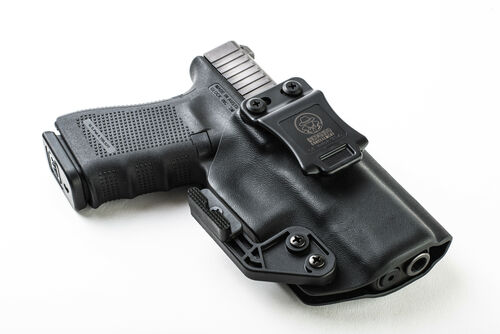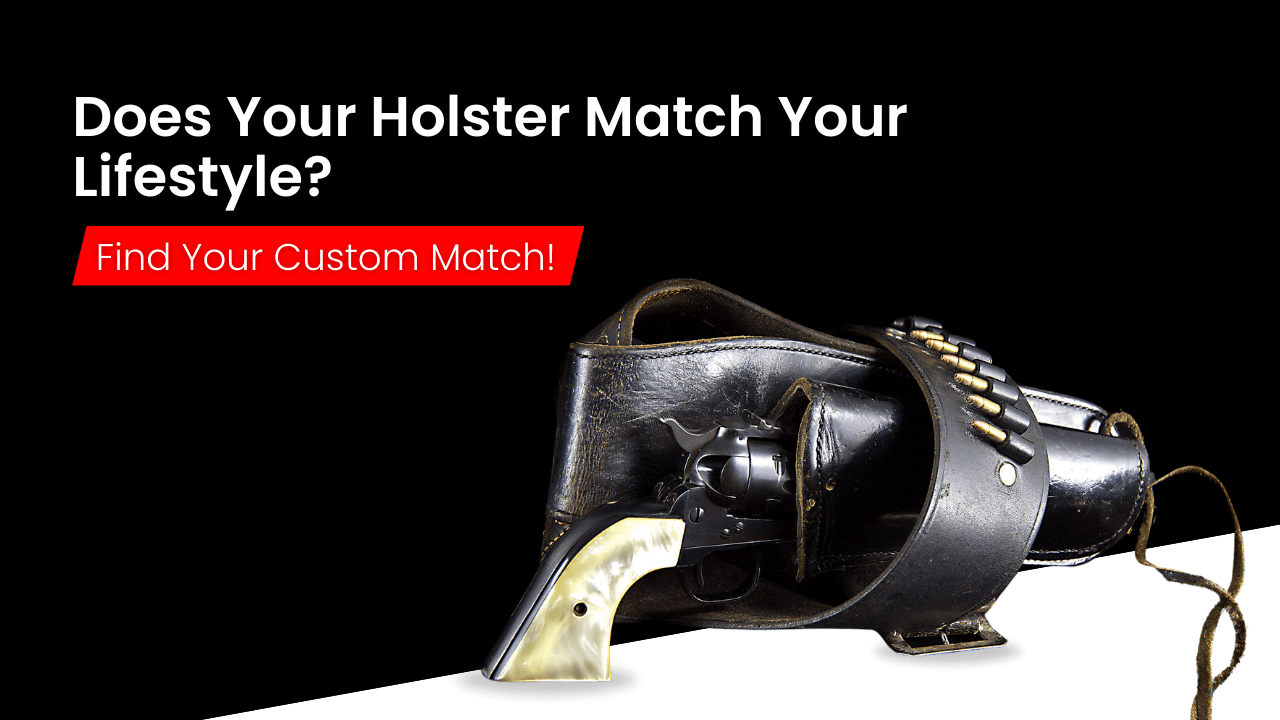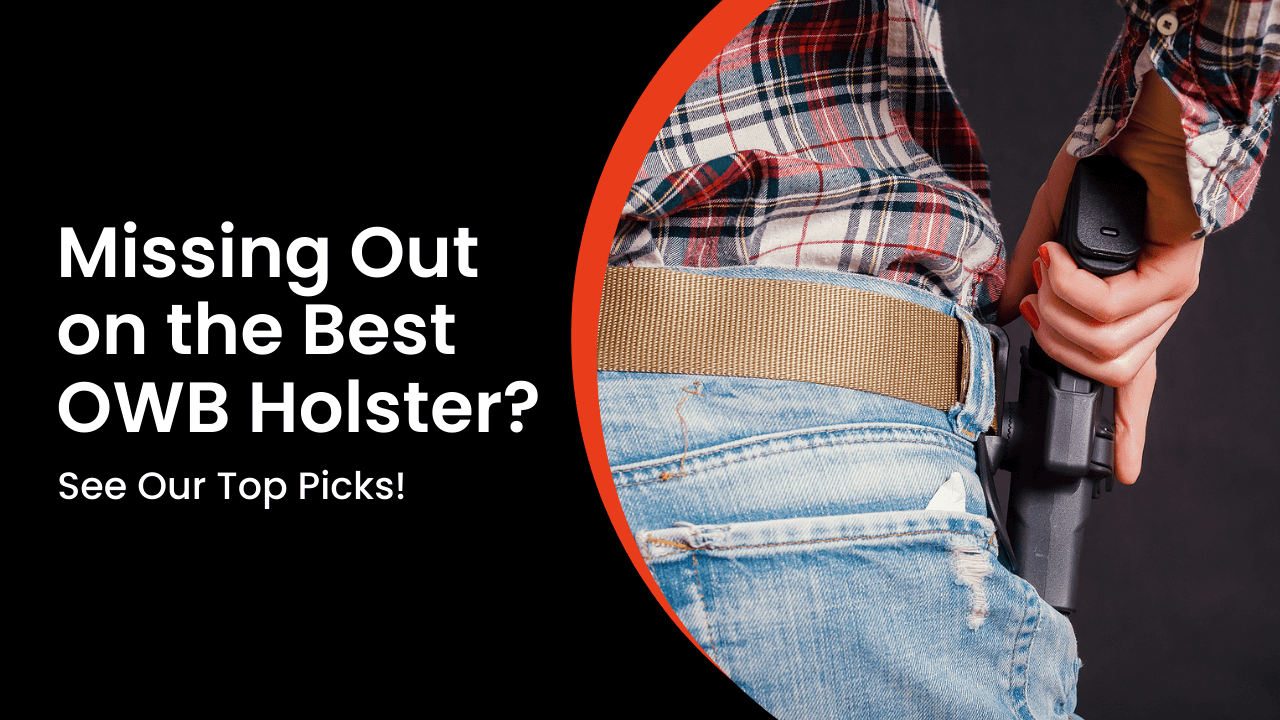Find the Best IWB Holster for the Glock 26
Jul 7th 2021
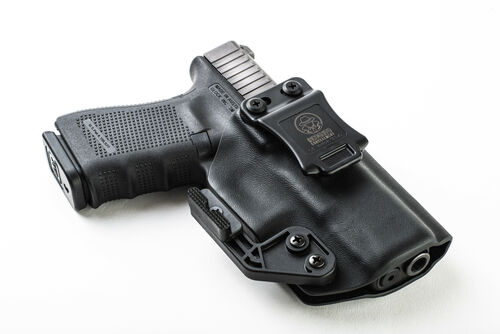
Glock Ges.m.b.H. introduced its first compact firearm in 1988 — the Glock 19. In the 1990s, as a result of the proliferation of shall-issue concealed-carry laws in the U.S., there was an increasing demand for concealable firearms. At the same time, plainclothes officers and detectives would often carry five-shot snub-nosed revolvers as backup weapons, such as the Smith & Wesson Chiefs Special.
In 1996, Glock introduced its first subcompact pistol — sometimes called the Baby Glock — to meet the increasing demand of civilians, private security personnel, and law enforcement agencies for a concealable, low-profile handgun chambered in 9×19mm Parabellum. Doubling the capacity of a .38-caliber snub-nosed revolver, the G26 is fed from a 10-round staggered-feed detachable box magazine.
If you’re contemplating carrying a G26 for personal protection, you need to find a good holster to maximize concealment, provide secure retention, and allow for an efficient draw stroke.
Glock 26 Concealability
As a subcompact handgun, the Glock 26 is more concealable than the compact Glock 19 or full-size Glock 17 pistols. The overall length is 6.5" with a 3.43" barrel, compared with 7.36” and 4.02", respectively, in the G19.
The width is the same as that of the G19 — 1.26". The weight difference is also minimal, with less than five ounces in loaded weight between the two.
However, the key difference, dimensionally, is the height. In the G19, the height from the top of the rear sight to the base of the magazine is 5.04". In the G26, it’s 4.17. That may not sound like a significant difference — less than ⅞ of an inch — however, the height of your firearm determines the extent to which it prints through clothing more than any other dimension.
G26 Controllability
If you’re interested in open carry, you should consider a compact or full-size weapon. As a concealed-carry handgun, the Glock 26 has a shorter frame and, thus, a shorter grip. The less gripping surface there is, and the lighter the weapon, the less controllable it is during rapid fire, all else being equal. This also applies to the Glock 43, although the G26 is heavier.
Essential Elements of an IWB Holster
The Glock 26 is ideal for IWB (inside-the-waistband) carry. In this carry method, the weapon and holster are positioned between the waistband of your pants and your body. For this carry method to be comfortable, you may need to wear a pants size up from what you normally wear. When selecting the best concealed carry holster, you should know what elements are essential.
Active vs. Passive Retention
Weapon retention is the extent to which the holster retains the firearm, preventing loss or an unauthorized user from drawing the weapon. In open-carry and OWB (outside-the-waistband) holsters, active retention is common, although not universal.
In an active-retention design, the holster positively locks the firearm in place. To draw the weapon, you need to manually unlock the weapon by releasing a thumb break or strap, depressing a button or lever, or rotating a hood.
In many IWB and OWB holsters designed for concealed carry, passive retention is common. In a passive-retention design, rather than positively locking the firearm in place, the holster retains the handgun through the application of friction. Hand-molded leather holsters can employ passive retention, requiring a tight fit. Leather tends to experience wear at an accelerated rate compared with other materials.
How Kydex Works
Kydex holsters are thermoformed to the exterior of the firearm for a snug fit. The thermoforming process consists of heating two sheets of Kydex to render the material soft and pliable, placing the sheets over a specific firearm, which acts as the mold and applying differential pressure to shape the sheet as required.
Manufacturers may use vacuum pressure, mechanical pressure, or air pressure to mold the Kydex. The result is a holster that has been precisely shaped for a particular weapon. The thermoforming process provides the passive retention.
The Draw Stroke
The system and level of retention also play an important role in the draw stroke. The draw stroke begins when you place your hand firmly on the weapon, acquiring a full firing grip. A passive-retention holster requires less manual dexterity to draw from. Instead, you simply apply upward pressure to overcome the friction and free the weapon from the holster’s grasp.
Always practice your draw stroke on a firing range from the position you intend to carry your weapon.
Kydex holsters also often allow for adjustable retention. If you have an available Phillips screwdriver, you can tighten or loosen one or two screws, ensuring an easy draw.
Durable Construction
A carry holster should be durable. Durability, in this sense, means that it should not deteriorate from regular use. Leather holsters can be durable — to an extent. Leather, even when chemically treated, can absorb moisture, causing its shape to change. Kydex, being a thermoplastic, is waterproof and offers increased strength. Its resistance to the elements makes it a good option for a carry holster.
The Importance of Rigidity
Among the most important factors regarding durability is rigidity. A carry holster should not be composed of a pliable material. Resistance to deformation is critical to reliable, safe functioning.
The holster mouth should remain open at all times, regardless of whether there’s a firearm in it. Holster mouths that collapse pose a hazard. First, when returning your weapon to its holster, you have to use your support hand to open a collapsible holster. This can complicate training and increase the risk that you will point the gun’s muzzle at yourself.
If you carry in the appendix position, there’s an elevated risk of death or serious injury in the event of an unintentional discharge on reholstering. This is due to the direction the gun’s muzzle is pointed in a neutral cant — your groin and femoral artery. Reholstering is already a high-risk activity on firing ranges and in the field to which you should pay careful attention.
If the holster edges deform, the holster material may enter the trigger guard on the downward stroke, activating the trigger and firing the weapon. The rigidity of Kydex material offers a distinct advantage in this regard.
Watch Your Clothing
In addition to choosing a rigid holster, practicing consistent trigger discipline, choosing a holster with a fully covered trigger guard, you should also be mindful of wearing loose-fitting clothing. No foreign debris should enter the holster mouth, and you should always ensure that any such material is swept away before returning your weapon to its holster.
Hardness
Related to durability and rigidity, the hardness of the holster can be an advantage or a downside. On the plus side, a hard holster shell is more resistant to abrasions. On the downside, the hardness of Kydex can impair the finish of your firearm. Kydex is also less compressible than competing holster materials, such as leather. This means that should you fall on your holster or the holster takes the force of a blunt impact, there will be less cushion and may cause an injury.
Noise or Feedback
Due to the thermoformed construction and hard shell, Kydex holsters tend to be noisier than those made from leather. This may be either a downside or a benefit, depending on your perspective. If you want to be able to reholster your firearm discreetly, the audible “click” of your pistol seating in the holster can be a liability. Other shooters find the audible feedback to be useful, indicating that the weapon is secure.
Affordability
A carry holster should not break the bank. Cost is always a factor — even more so when you’re on a strict budget. Your holster choice should meet specific criteria and standards of craftsmanship, but good quality doesn’t need to be prohibitively expensive. You should still be able to afford other vital accessories and ammunition for range practice.
Lightweight Design
A carry holster should not be heavy — you’re using it to wear a lightweight, concealable firearm. Fortunately, Kydex products are crafted using thin thermoplastic sheets, resulting in a lightweight holster that shouldn’t encumber you.
Gun Belt
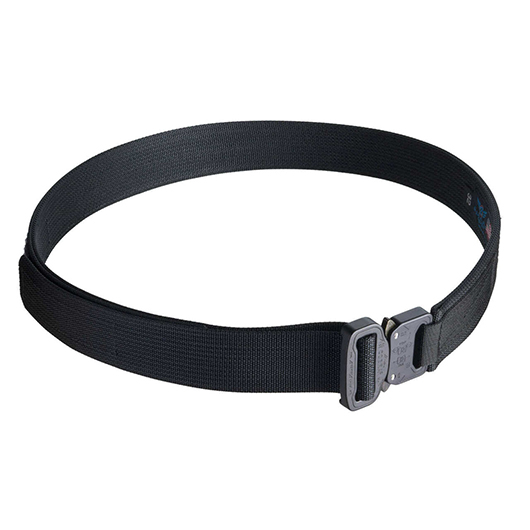
An accessory that is almost as important as your holster is a high-quality gun belt. A gun belt supports the weight of your firearm and keeps it in one position. Unlike a dress belt, a gun belt is more rigid and durably constructed. It should resist the abrasion of belt clips and belt loops and prevent the gun from sagging outward and away from your body. This is critical to preventing printing and keeping your weapon available to you at all times.
Belt Clips
IWB holsters can use either a single belt clip or a pair to attach to your gun belt. These clips evenly distribute the holster’s weight and firearm on the belt and ensure that the holster remains secure during the draw stroke. Belt clips attach in a variety of different ways, depending on the design.
Standard belt clips include J clips, which lay over the top and front of the belt, hooking onto the underside. C clips attach from the top and the bottom, minimizing exposure. This is an advantage for the most discreet carry options, including when using a holster that can accommodate tuckable belt clips.
Tuckable Holsters
One of the advantages of IWB holsters is that they can be tuckable, depending on the design. This means that you can tuck a T-shirt or collared shirt into a space between the holster and the belt clip. The result is that the only visible firearm accessory is the belt clip. The holster is rendered invisible. To ensure the utmost discretion, you can choose belt clips that match the color of your gun belt.
A tuckable holster for your G26 allows you to wear your weapon at the office or in any location where deep concealment is a must and dress codes apply. If you decide to carry your weapon in this fashion, you must practice your draw stroke.
Drawing a pistol from a tuckable holster requires a different set of movements than you may be used to. Rather than simply lifting your shirt with one hand or sweeping a jacket to the side, you need to untuck your shirt and lift it out of the way. This often requires more force and practice to perform smoothly.
If you carry in the appendix position, you’ll grip your shirt fabric with both hands — tightly — as close to the beltline as possible. Lift your shirt up forcefully and immediately grip your weapon with your strong hand while your support hand remains on your clothing.
Adjustable Cant and Ride Height
When you carry a handgun in a waistband holster, the cant is the carry angle — i.e., the forward (positive) or rearward (negative) rotation of the firearm relative to the centerline of your gun belt. If the firearm is perpendicular relative to the ground, the cant is neutral.
There are two primary reasons to adjust the cant on a firearm:
Improving comfort and accessibility
If you carry your handgun on or behind your strong-side hip, you need more of a forward cant to maintain access to your weapon. The more positive the cant, the more the butt of the weapon rises. The advantage of this is that it increases the clearance between the weapon and the top of the belt. It also allows you to avoid contorting your shoulder to draw your pistol.
Increasing concealment
As canting the firearm forward causes the butt of the pistol to rise, it is less apt to protrude through clothing, whether that’s a T-shirt or a jacket. The G26, having a relatively short frame, already prints less than many other handguns in this caliber. By rotating the grip upward, printing is virtually eliminated.
Cant is typically expressed in degrees. A cant of 15–22.5° is considered ideal for strong-side carry — this is also called the FBI cant. In appendix carry, a neutral cant of 0° is preferable. Finding a carry holster featuring an adjustable cant allows you to find the perfect degree of rotation for your preferred carry position and method.
In addition to the cant, your holster should also allow you to set the ride height, which is how high or low the holster sits in relation to your belt. The lower the ride height, the more of your gun is concealed by your pants. However, a low ride height also reduces the space between the front strap of the pistol and the top of your waistband. You’ll need to balance the cant and the ride height to achieve the perfect position for your needs.
Trigger Guard
Consistent observance of firearms safety rules requires that you practice trigger discipline. This means keeping your finger off the trigger and the exterior of the trigger guard until you have lined up your target and you’re ready to fire. To help you follow this rule, the best holsters have a fully covered trigger guard. It should not be physically possible for your finger or a foreign object to enter the trigger guard until the weapon has cleared the holster. This protects you and others by preventing the trigger from being activated until the weapon is out of the holster.
Sweat Guard
Many high-quality concealed-carry holsters have sweat guards. In a Kydex holster, the sheet that forms the rear of the holster extends upward to partially or fully cover the slide. This is the sweat guard or shield. Its purpose is to provide a sweat-resistant barrier between the firearm and your body. Sweat can have a highly corrosive effect on steel, and although Glock firearms are treated to protect against rust, sweat can still cause damage over time.
Sight Channel
If you have high-profile combat or night sights on your handgun, you should ensure that the holster has a sight channel that can accommodate the increased bulk of these aiming markers.
Magazine Carriers
Magazine pouches, or mag carriers, allow you to carry additional ammunition for your sidearm. Handguns suitable for concealed carry tend to hold fewer rounds per magazine to minimize bulk and maximize concealment. The Glock 26 has a standard magazine capacity of 10 rounds, which is a reasonable compromise. Ten rounds in the magazine plus one in the chamber should provide you with ample firepower to incapacitate or repel a criminal assailant.
However, you can never predict how many rounds you will need to stop a threat. If you find yourself in an active shooter situation or your adversary is wearing body armor, your ammunition requirements may change. Rather than having to return to your vehicle to resupply, carrying one or two spare magazines on your support side can provide you with the firepower you need to resolve any situation.
Carry Your Glock 26 Safely and Securely With an Incognito Concealment Holster
There are a wide variety of subcompact firearms on the market today to meet the needs of American gun owners. Concealed carry is one of the ways in which almost 20 million Americans exercise their right to keep and bear arms. Everyone who carries a firearm concealed or openly needs a holster that’s worthy of their carry weapon. The Glock has a reputation for world-class reliability and ruggedness.
At Incognito Concealment, we manufacture the finest Kydex holsters available to meet a variety of customer needs. By molding our holster shells to perfectly fit a wide variety of handguns, you can rest assured that the holster you buy will fit your gun like a glove. Check out our products. If you can’t find the make or model of your firearm, give us a call. We’d be happy to help. If we don’t manufacture a holster for your weapon, we can make one on a custom basis for you.
FAQs
Is the Glock 26 still relevant?
The G26 remains relevant because it is still useful and hasn’t been entirely replaced by other firearms. The newer G43 is lighter and more compact but has a lower magazine capacity — six rounds instead of 10.
What is the best method for concealed carry if you’re overweight?
Strong-side carry is most appropriate for those with frontal girth. You may find IWB more difficult, but not always. OWB can be more comfortable.
Experiment with various holster designs, carry methods, and positions to see which one works for you. Ideally, you should wear your holster while sitting, standing, moving, driving, and performing other tasks to see where the weak points are.
Is the Glock 26 the best for concealed carry?
The Glock 26 has several advantages relative to other concealed-carry firearms. However, whether it’s the best depends on your preferences. If you want the most compact Glock firearm available with the highest magazine capacity, the G26 is undoubtedly the best Glock. Competing weapons, for which we also offer holsters, include the Springfield Armory Hellcat and SIG Sauer P365.

